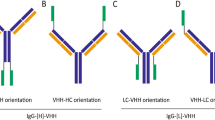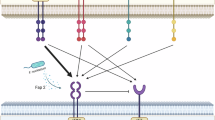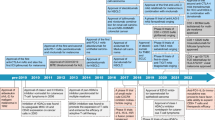Abstract
Background
T-cell immunoreceptor with immunoglobulin (Ig) and ITIM domains (TIGIT) is a checkpoint receptor thought to be involved in mediating T-cell exhaustion and dysfunction of natural killer (NK) cells in tumours and is emerging as novel promising targets in immunotherapy, however, the ligand binding and the efficacy of its antibody still need to be further explored.
Methods
Four different TIGIT antibodies in characteristics of antigen binding, in vitro effects on activated T cells, Fc region functions and tumour inhibition in animal models were compared. The antibody as monotherapy and combined with anti-PD-L1 antibody, effects on PBMC in ex vivo coculture with autologous human CRC organoids as well as PK profile were evaluated.
Results
Studies demonstrated that TIGIT antibody with PVR-competitive ability as monotherapy resulted in inhibition of tumour growth, sustained anti-tumour immune memory in tumour re-challenge mice, enhanced anti-tumour therapy in combination with anti-PD-L1. Ex vivo coculture assay suggested that TIGIT antibody treatment activated immune cells and promoted infiltration and tumour killing ability of autologous PBMC in human CRC organoids.
Conclusions
Our study broadens the knowledge of TIGIT antibody in cancer immunotherapy and may benefit future development of next-generation checkpoint inhibitors with improved clinical outcomes.

This is a preview of subscription content, access via your institution
Access options
Subscribe to this journal
Receive 24 print issues and online access
$259.00 per year
only $10.79 per issue
Buy this article
- Purchase on SpringerLink
- Instant access to full article PDF
Prices may be subject to local taxes which are calculated during checkout







Similar content being viewed by others
Data availability
All data analysed during this study are included in this published article.
Change history
07 August 2025
The original online version of this article was revised: In this article the author contribution statement was originally missing; this has now been corrected. The author contribution statement is as follows: These authors contributed equally: Huijuan Yu, Shaowen Jin.
12 August 2025
A Correction to this paper has been published: https://doi.org/10.1038/s41416-025-03084-4
References
Worboys JD, Vowell KN, Hare RK, Ambrose AR, Bertuzzi M, Conner MA, et al. TIGIT can inhibit T cell activation via ligation-induced nanoclusters, independent of CD226 co-stimulation. Nat Commun. 2023;14:5016 https://doi.org/10.1038/s41467-023-40755-3.
Liu S, Zhang H, Li M, Hu D, Li C, Ge B, et al. Recruitment of Grb2 and SHIP1 by the ITT-like motif of TIGIT suppresses granule polarization and cytotoxicity of NK cells. Cell Death Differ. 2013;20:456–64. https://doi.org/10.1038/cdd.2012.141.
Khan M, Arooj S, Wang H. NK cell-based immune checkpoint inhibition. Front Immunol. 2020;11:167 https://doi.org/10.3389/fimmu.2020.00167.
Valhondo I, Hassouneh F, Lopez-Sejas N, Pera A, Sanchez-Correa B, Guerrero B, et al. Characterization of the DNAM-1, TIGIT and TACTILE axis on circulating NK, NKT-Like and T cell subsets in patients with acute myeloid leukemia. Cancers. 2020;12:2171–89. https://doi.org/10.3390/cancers12082171.
Cho BC, Abreu DR, Hussein M, Cobo M, Patel AJ, Secen N, et al. Tiragolumab plus atezolizumab versus placebo plus atezolizumab as a first-line treatment for PD-L1-selected non-small-cell lung cancer (CITYSCAPE): primary and follow-up analyses of a randomised, double-blind, phase 2 study. Lancet Oncol. 2022;23:781–92. https://doi.org/10.1016/S1470-2045(22)00226-1.
Finn RS, Hsu CH, Li D, Burgoyne A, Cotter C, et al. Results from the MORPHEUS-liver study: phase Ib/II randomized evaluation of tiragolumab (tira) in combination with atezolizumab (atezo) and bevacizumab (bev) in patients with unresectable, locally advanced or metastatic hepatocellular carcinoma (uHCC). J Clin Oncol. 2023;41:1.
Roche reports update on Phase III SKYSCRAPER-01 study results. News release Roche. 2024. https://www.roche.com/media/releases/med-cor-2024-11-26.
Rudin CM, Liu SV, Soo RA, Lu S, Hong MH, Lee JS, et al. SKYSCRAPER-02: tiragolumab in combination with atezolizumab plus chemotherapy in untreated extensive-stage small-cell lung cancer. J Clin Oncol. 2024;42:324–35. https://doi.org/10.1200/JCO.23.01363.
Socinski MA, Rodriguez Abreu D, Lee DH, Cappuzzo F, Nishio M, Lovly CM, et al. LBA2 SKYSCRAPER-06: efficacy and safety of tiragolumab plus atezolizumab plus chemotherapy (tira + atezo + chemo) vs pembrolizumab plus chemotherapy (pembro + chemo) in patients (pts) with advanced non-squamous non-small cell lung cancer (NSq NSCLC). Immuno-Oncol. Technol. 2024;24; https://doi.org/10.1016/j.iotech.2024.101025.
Rudin CM, Liu SV, Soo RA, Lu S, Hong MH, Lee JS, et al. KeyVibe-008: randomized, phase 3 study of first-line vibostolimab plus pembrolizumab plus etoposide/platinum versus atezolizumab plus EP in extensive-stage small cell lung cancer. J Clin Oncol. 2024;42:324–35. https://doi.org/10.1200/JCO.23.01363.
GlobeNewswire. iTeos Therapeutics Announces Late-Breaking Oral Presentation of Phase 2 GALAXIES Lung-201 Interim Data at the European Society for Medical Oncology Congress 2024. iTeos Therapeutics Inc. 2024.
Janjigian YY, Oh DY, Pelster MS, Wainberg ZA, Sison EA, Jack R, et al. EDGE-gastric arm A1- phase 2 study of domvanalimab, zimberelimab, and FOLFOX in first-line (1L) advanced gastroesophageal cancer. J Clin Oncol. 2023;41:1.
Johnson ML, Fox W, Lee YG, Lee KH, Ahn HK, Kim YC, et al. ARC-7- randomized phase 2 study of domvanalimab + zimberelimab ± etrumadenant versus zimberelimab in first-line, metastatic, PD-L1-high non-small cell lung cancer (NSCLC). J Clin Oncol. 2022;40:1.
Naidoo J, Peters S, Runglodvatana Y, Li JY-C, Fong CH, Ho GF, et al. Phase 2 randomized study of domvanalimab combined with zimberelimab in front-line, PD-(L)1 high, locally advanced or metastatic non-small cell lung cancer (NSCLC): results from ARC-10 part 1. J Immunother Cancer. 2024;12(Suppl 3):A1690–A1691. https://doi.org/10.1136/jitc-2024-SITC2024.1461.
Zhang Q, Bi J, Zheng X, Chen Y, Wang H, Wu W, et al. Blockade of the checkpoint receptor TIGIT prevents NK cell exhaustion and elicits potent anti-tumor immunity. Nat Immunol. 2018;19:723–32. https://doi.org/10.1038/s41590-018-0132-0.
Xu F, Sunderland A, Zhou Y, Schulick RD, Edil BH, Zhu Y. Blockade of CD112R and TIGIT signaling sensitizes human natural killer cell functions. Cancer Immunol Immunother. 2017;66:1367–75. https://doi.org/10.1007/s00262-017-2031-x.
Boles KS, Vermi W, Facchetti F, Fuchs A, Wilson TJ, Diacovo TG, et al. A novel molecular interaction for the adhesion of follicular CD4 T cells to follicular DC. Eur J Immunol. 2009;39:695–703. https://doi.org/10.1002/eji.200839116.
Yu X, Harden K, Gonzalez LC, Francesco M, Chiang E, Irving B, et al. The surface protein TIGIT suppresses T cell activation by promoting the generation of mature immunoregulatory dendritic cells. Nat Immunol. 2009;10:48–57. https://doi.org/10.1038/ni.1674.
Brauneck F, Fischer B, Witt M, Muschhammer J, Oelrich J, da Costa Avelar PH, et al. TIGIT blockade repolarizes AML-associated TIGIT(+) M2 macrophages to an M1 phenotype and increases CD47-mediated phagocytosis. J Immunother Cancer. 2022;10:e004794. https://doi.org/10.1136/jitc-2022-004794.
Shin SM, Choi DK, Jung K, Bae J, Kim JS, Park SW, et al. Antibody targeting intracellular oncogenic Ras mutants exerts anti-tumour effects after systemic administration. Nat Commun. 2017;8:15090 https://doi.org/10.1038/ncomms15090.
Sanchez-Correa B, Valhondo I, Hassouneh F, Lopez-Sejas N, Pera A, Bergua JM, et al. DNAM-1 and the TIGIT/PVRIG/TACTILE axis: novel immune checkpoints for natural killer cell-based cancer immunotherapy. Cancers. 2019;11:877 https://doi.org/10.3390/cancers11060877.
Lu Y, Huang Y, Huang L, Xu Y, Wang Z, Li H, et al. CD16 expression on neutrophils predicts treatment efficacy of capecitabine in colorectal cancer patients. BMC Immunol. 2020;21:46–60. https://doi.org/10.1186/s12865-020-00375-8.
Wang XY, Wang B, Wen YM. From therapeutic antibodies to immune complex vaccines. NPJ Vaccines. 2019;4:2 https://doi.org/10.1038/s41541-018-0095-z.
Liu H, Guo L, Zhang J, Zhou Y, Zhou J, Yao J, et al. Glycosylation-independent binding of monoclonal antibody toripalimab to FG loop of PD-1 for tumor immune checkpoint therapy. MAbs. 2019;11:681–90. https://doi.org/10.1080/19420862.2019.1596513.
Oostindie SC, Lazar GA, Schuurman J, Parren P. Avidity in antibody effector functions and biotherapeutic drug design. Nat Rev Drug Discov. 2022;21:715–35. https://doi.org/10.1038/s41573-022-00501-8.
Zhang B, Zhang J, Li Y, Li N, Wang Y, Jang R, et al. In situ STING-activating nanovaccination with TIGIT blockade for enhanced immunotherapy of anti-PD-1-resistant tumors. Adv Mater. 2023;35:e2300171 https://doi.org/10.1002/adma.202300171.
Guan X, Hu R, Choi Y, Srivats S, Nabet BY, Silva J, et al. Anti-TIGIT antibody improves PD-L1 blockade through myeloid and T(reg) cells. Nature. 2024;627:646–55. https://doi.org/10.1038/s41586-024-07121-9.
Kim TW, Bedard PL, LoRusso P, Gordon MS, Bendell J, Oh DY, et al. Anti-TIGIT antibody tiragolumab alone or with atezolizumab in patients with advanced solid tumors: a phase 1a/1b nonrandomized controlled trial. JAMA Oncol. 2023;9:1574–82. https://doi.org/10.1001/jamaoncol.2023.3867.
Dekkers G, Bentlage AEH, Stegmann TC, Howie HL, Lissenberg-Thunnissen S, Zimring J, et al. Affinity of human IgG subclasses to mouse Fc gamma receptors. MAbs. 2017;9:767–73. https://doi.org/10.1080/19420862.2017.1323159.
Dimitrov DS. Therapeutic proteins. Methods Mol Biol. 2012;899:1–26. https://doi.org/10.1007/978-1-61779-921-1_1.
Liu L. Pharmacokinetics of monoclonal antibodies and Fc-fusion proteins. Protein Cell. 2018;9:15–32. https://doi.org/10.1007/s13238-017-0408-4.
Suzuki T, Ishii-Watabe A, Tada M, Kobayashi T, Kanayasu-Toyoda T, Kawanishi T, et al. Importance of neonatal FcR in regulating the serum half-life of therapeutic proteins containing the Fc domain of human IgG1: a comparative study of the affinity of monoclonal antibodies and Fc-fusion proteins to human neonatal FcR. J Immunol. 2010;184:1968–76. https://doi.org/10.4049/jimmunol.0903296.
Joller N, Lozano E, Burkett PR, Patel B, Xiao S, Zhu C, et al. Treg cells expressing the coinhibitory molecule TIGIT selectively inhibit proinflammatory Th1 and Th17 cell responses. Immunity. 2014;40:569–81. https://doi.org/10.1016/j.immuni.2014.02.012.
Levin SD, Taft DW, Brandt CS, Bucher C, Howard ED, Chadwick EM, et al. Vstm3 is a member of the CD28 family and an important modulator of T-cell function. Eur J Immunol. 2011;41:902–15. https://doi.org/10.1002/eji.201041136.
Judge SJ, Darrow MA, Thorpe SW, Gingrich AA, O’Donnell EF, Bellini AR, et al. Analysis of tumor-infiltrating NK and T cells highlights IL-15 stimulation and TIGIT blockade as a combination immunotherapy strategy for soft tissue sarcomas. J Immunother Cancer. 2020;8:e001355. https://doi.org/10.1136/jitc-2020-001355.
Guillerey C, Harjunpaa H, Carrie N, Kassem S, Teo T, Miles K, et al. TIGIT immune checkpoint blockade restores CD8(+) T-cell immunity against multiple myeloma. Blood. 2018;132:1689–94. https://doi.org/10.1182/blood-2018-01-825265.
Kong Y, Zhu L, Schell TD, Zhang J, Claxton DF, Ehmann WC, et al. T-cell immunoglobulin and ITIM domain (TIGIT) associates with CD8+ T-cell exhaustion and poor clinical outcome in AML patients. Clin Cancer Res. 2016;22:3057–66. https://doi.org/10.1158/1078-0432.CCR-15-2626.
Chauvin JM, Zarour HM. TIGIT in cancer immunotherapy. J Immunother Cancer. 2020;8:e000957. https://doi.org/10.1136/jitc-2020-000957.
Schorer M, Rakebrandt N, Lambert K, Hunziker A, Pallmer K, Oxenius A, et al. TIGIT limits immune pathology during viral infections. Nat Commun. 2020;11:1288 https://doi.org/10.1038/s41467-020-15025-1.
Fourcade J, Sun Z, Chauvin JM, Ka M, Davar D, Pagliano O, et al. CD226 opposes TIGIT to disrupt Tregs in melanoma. JCI Insight. 2018;3:e121157. https://doi.org/10.1172/jci.insight.121157.
Kurtulus S, Sakuishi K, Ngiow SF, Joller N, Tan DJ, Teng MW, et al. TIGIT predominantly regulates the immune response via regulatory T cells. J Clin Investig. 2015;125:4053–62. https://doi.org/10.1172/JCI81187.
Tekguc M, Wing JB, Osaki M, Long J, Sakaguchi S. Treg-expressed CTLA-4 depletes CD80/CD86 by trogocytosis, releasing free PD-L1 on antigen-presenting cells. Proc Natl Acad Sci USA. 2021;118:e2023739118. https://doi.org/10.1073/pnas.2023739118.
Walker LS. Treg and CTLA-4: two intertwining pathways to immune tolerance. J Autoimmun. 2013;45:49–57. https://doi.org/10.1016/j.jaut.2013.06.006.
Han JH, Cai M, Grein J, Perera S, Wang H, Bigler M, et al. Effective anti-tumor response by TIGIT blockade associated with FcγR engagement and myeloid cell activation. Front Immunol. 2020;11:573405 https://doi.org/10.3389/fimmu.2020.573405.
Waight JD, Chand D, Dietrich S, Gombos R, Horn T, Gonzalez AM, et al. Selective FcgammaR Co-engagement on APCs modulates the activity of therapeutic antibodies targeting T cell antigens. Cancer Cell. 2018;33:1033–1047.e1035. https://doi.org/10.1016/j.ccell.2018.05.005.
Geels SN, Moshensky A, Sousa RS, Murat C, Bustos MA, Walker BL, et al. Interruption of the intratumor CD8(+) T cell:Treg crosstalk improves the efficacy of PD-1 immunotherapy. Cancer Cell. 2024;42:1051–1066.e1057. https://doi.org/10.1016/j.ccell.2024.05.013.
Banta KL, Xu X, Chitre AS, Au-Yeung A, Takahashi C, O’Gorman WE, et al. Mechanistic convergence of the TIGIT and PD-1 inhibitory pathways necessitates co-blockade to optimize anti-tumor CD8(+) T cell responses. Immunity. 2022;55:512–526 e519. https://doi.org/10.1016/j.immuni.2022.02.005.
Acknowledgements
This work was supported by the National Natural Science Foundation of China (Grant No. 82104228), the GDAS Special Project of Science and Technology Development (Grant No. 2021GDASYL–20210103057, 2023GDASZH-2023030602-01).
Author information
Authors and Affiliations
Contributions
Xiaofei Wang contributed to the conception and design of the study, Huijuan Yu, Min Zeng, Zhiqing Yang and Shaowen Jin were involved in data collection, analysis, and interpretation. Huijuan Yu contributed to drafting the manuscript. Xiaofei Wang provided critical revisions. All authors approved the final version of the manuscript and agreed to be accountable for all aspects of the work.
Corresponding author
Ethics declarations
Competing interests
The authors declare no competing interests.
Additional information
Publisher’s note Springer Nature remains neutral with regard to jurisdictional claims in published maps and institutional affiliations.
The original online version of this article was revised: In this article the author contribution statement was originally missing; this has now been corrected. The author contribution statement is as follows: These authors contributed equally: Huijuan Yu, Shaowen Jin.
Supplementary information
Rights and permissions
Springer Nature or its licensor (e.g. a society or other partner) holds exclusive rights to this article under a publishing agreement with the author(s) or other rightsholder(s); author self-archiving of the accepted manuscript version of this article is solely governed by the terms of such publishing agreement and applicable law.
About this article
Cite this article
Yu, H., Jin, S., Zeng, M. et al. TIGIT antibody with PVR competitive ability enhances cancer immunotherapy and capable of eliciting anti-tumour immune memory. Br J Cancer 133, 743–755 (2025). https://doi.org/10.1038/s41416-025-03046-w
Received:
Revised:
Accepted:
Published:
Issue date:
DOI: https://doi.org/10.1038/s41416-025-03046-w
This article is cited by
-
The value of acetylation reader YEATS2 in hepatocellular carcinoma management
Scientific Reports (2025)



